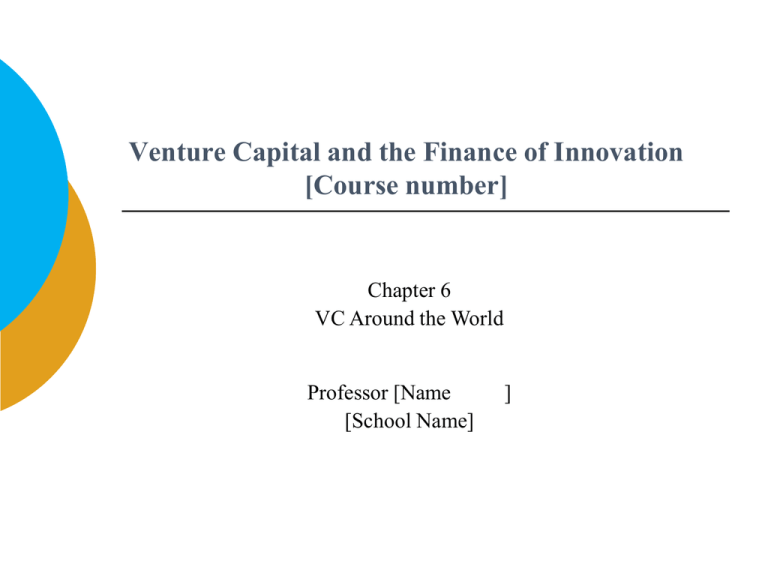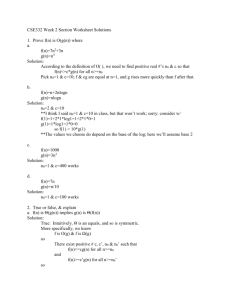Overpricing (puzzle) in the corporate bond offerings
advertisement

Venture Capital and the Finance of Innovation [Course number] Chapter 6 VC Around the World Professor [Name [School Name] ] The Global Distribution of High-Tech Private-Equity Investment, 2007, Top-20 Countries, in $Billions Source: PWC Global Private Equity Report 2008. Upsides for making VC investments outside the U.S. 1. Investment opportunities for high-growth tech start-ups • • • Regional / domestic consumer market potential ($$$$) Cheaper and competitive local talent pool (Human capital) Technological advantage 2. Competition with other VCs/Investors: Less money chasing deals • But: Sign of “too much money” in China already… 1. Main challenges include exit opportunities But: improving track records of non-U.S. firm exits U.S. IPOs (Israel, Chinese companies especially) Non-U.S. IPOs (China, AIM, India, Taiwan, Japan) Large M&A sales (e.g. skype, Alibaba) What are remaining challenges? 1. Exits 2. Legal / Country Risk 3. Entrepreneurial Ecosystem Ratio of capital raised in IPOs (in $thousands) to GDP (in $millions), 1996 -2000 Who has large capital markets? What do they have in common? Exits IPO exits IPOs have generated the most profitable exits for VCs Success of non-U.S. VC-backed companies to exit via IPOs have been limited to a few: Israel, China, India, other Asian countries Success has been less sustainable elsewhere (e.g., Europe) M&A exits More broadly available options and shorter time to exit, but average returns more muted Index of Protections Against Self-Dealing (higher = more protections) Investor protections are again higher in UK lawbased countries Lower in continental Europe & Latin America This index does not measure one’s ability to enforce contracts Nor does it measure the state’s power to override the rule of law Sovereign Spread of Dollar-Denominated Bonds Sovereign spread is sometimes used as measure of “country risk”. But: better job of measuring monetary / fiscal fragility of governments than purely political risk and/or corruption Attitudes towards entrepreneurship % of respondents saying yes to the question “Do you have the knowledge, skill, and experience to start a new business?” What do the crosscountry differences imply about doing VC in these countries? Surveys done in 18 countries only. Cost of capital for international VC What cost of capital should (big, diversified) investors expect to earn from investing in international VC? Again, not entrepreneurs Not venture capitalists International Portfolio Diversification Because foreign stocks are not perfectly correlated with domestic returns, combining foreign and domestic assets significantly reduce risk. Standard deviation of portfolio returns can be reduced with international diversification Cost of equity with integrated markets For globally-diversified U.S. investors making investments in company i in country X, r$i = r$f + βGi ( r$G - r$f ) where r$f = risk-free rate in U.S. dollars r$G = expected global market return Sometimes proxied by the Morgan-Stanley International Index MSCI Premium estimates range 7-8% βGi = beta of the company’s stock i against global equity market Estimating beta with data limitations For companies in many countries, data needed to obtain good estimates of their global beta are unavailable. Analysts often decompose the beta to two components, one that captures the industry’s correlation with a national stock market, and another that captures the nation’s correlation with the global stock market. βG,i(software) = βG, India * βIndia, software For example, for a software company i in India, βIndia, software is how software industry companies are correlated with the Indian stock market, and βG, India represents how Indian stock market is correlated with the global stock market (G) What if βIndia, software is not available? Then βG, i = βG, X * βX, i ≈ βG, X * βUS, i where βUS, i = estimate of beta for U.S. companies in the software industry with respect to the U.S. stock market, used as a proxy βG,X = estimate of country beta for country X with respect to the global market COUNTRY BETAS, SELECTED COUNTRIES Note: calculated based on daily index stock returns from 1998 to 2008. Note: calculated based on daily index stock returns from 1998 to 2008. Cost of Capital for International VC We make model adjustments similar to those we made for calculating the cost of capital for domestic (U.S.) VC. From Class 2 (Chapter 4): We estimated U.S. VC cost of capital as: rUSVC = rf + βmarket, VC * (rm – rf) + βsize, VC * SIZE + βvalue, VC * VALUE rUSVC= U.S. VC return, + βliq, VC * LIQ, where rf = risk-free rate, rm – rf = market premium, SIZE , VALUE, and LIQ are factor premia for the three factors, and βsize, VC, βvalue, VC, and βliq, VC are their betas. Using estimates of 4% (risk-free) 7% (market premium), 2.5% (size), 3.5% (value), and 5% (liquidity), and using beta estimates, we obtain rUSVC = 15% (average of the two from Cambridge and Sand Hill data). This gives us: Βmarket*(rm–rf) + βsize*SIZE + βvalue*VALUE +βliq*LIQ = 15% − 4% = 11%. A global multifactor model for VC Since we almost always lack data to do this exercise for non-U.S. countries, we use the same trick using beta decomposition into country beta (βGX) and U.S. domestic (market, size, value, liquidity, instead of industry) beta. Keep everything in US$. G = global, X= country X, US = U.S. For VC investment in country X, its cost of capital, rXVC , is: rXVC = rf + βmarket(G), VC(X) * (RGm – RGf) + βsize(G), VC(X) * SIZEG + βvalue(G), VC(X) * VALUEG + βliq(G), VC(X) * LIQG = rf + βGX* βXmarket, VC * (Rm – Rf) + βGX * βX size, VC * SIZE + βGX *βXvalue, VC * VALUE + βGX * βX liq, VC * LIQ ≈ rf + βGX* βUSmarket, VC * (Rm – Rf) + βGX * βUSsize, VC * SIZE + βGX *βUSvalue, VC * VALUE + βGX * βUS liq, VC * LIQ = rf + βGX* [ βUSmarket, VC * (Rm – Rf) + βUSsize, VC * SIZE + βUSvalue, VC * VALUE + βUS liq, VC * LIQ ] = 4% + βGX* [15% − 4% ]. Objections and extensions Style effects Currency risk Country risk Segmented markets





